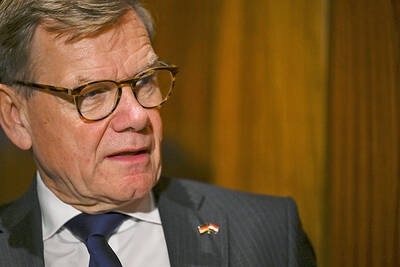Of the 82 wind turbines that make up Taiwan Power Co's (Taipower, (台電) wind-powered energy generation plans, as many as 51 turbines have at one time or another been inoperative.
Taipower blames the high rate of malfunctioning on Taiwan’s hot climate and lack of supporting equipment. The high rate of breakdown is a significant setback to the implementation of the government’s renewable energy policy.
To meet government targets for clean energy, Taipower planned to invest NT$19 billion (US$624 million) in 180 wind turbines, with a total capacity of 330,000 kilowatts, between 2003 and 2010. However, to date, only 82 have been completed, with the malfunction rate reaching a high 62 percent.
Taipower said that, of the malfunctioning turbines, three were manufactured by GE, 22 by Harakosan and six by Gamesa. Most of the turbines are distributed along the western shoreline.
In terms of generation, the 82 completed turbines have generated 560 million kilowatt-hours of electricity. At NT$2 per kilowatt-hour, the turbines have generated NT$1.12 billion, a miniscule sum compared with its investment of nearly NT$10 billion.
As for capacity utilization, only the turbines in Penghu County and Changhua County were able to operate at 47 percent and 35 percent respectively. In other areas, such as in Shihmen (石門), Taipei County, and Hengchun (恆春), Pingtung County, the turbines were operating at less than 30 percent capacity.
Commenting on the major problems surrounding wind power generation, an unnamed director from Taipower described the situation as “utterly ridiculous.” Some Taipower staff also questioned the fact that the department in charge of wind-power generation had not been held responsible nor faced disciplinary action.
Sources say that the 51 faulty turbines were all contract based on the most advantageous, rather than the lowest, bids.

The German city of Hamburg on Oct. 14 named a bridge “Kaohsiung-Brucke” after the Taiwanese city of Kaohsiung. The footbridge, formerly known as F566, is to the east of the Speicherstadt, the world’s largest warehouse district, and connects the Dar-es-Salaam-Platz to the Brooktorpromenade near the Port of Hamburg on the Elbe River. Timo Fischer, a Free Democratic Party member of the Hamburg-Mitte District Assembly, in May last year proposed the name change with support from members of the Social Democratic Party and the Christian Democratic Union. Kaohsiung and Hamburg in 1999 inked a sister city agreement, but despite more than a quarter-century of

Taiwanese officials are courting podcasters and influencers aligned with US President Donald Trump as they grow more worried the US leader could undermine Taiwanese interests in talks with China, people familiar with the matter said. Trump has said Taiwan would likely be on the agenda when he is expected to meet Chinese President Xi Jinping (習近平) next week in a bid to resolve persistent trade tensions. China has asked the White House to officially declare it “opposes” Taiwanese independence, Bloomberg reported last month, a concession that would mark a major diplomatic win for Beijing. President William Lai (賴清德) and his top officials

The Ministry of Foreign Affairs (MOFA) yesterday expressed “grave concerns” after Singaporean Prime Minister Lawrence Wong (黃循財) reiterated the city-state’s opposition to “Taiwanese independence” during a meeting with Chinese Premier Li Qiang (李強). In Singapore on Saturday, Wong and Li discussed cross-strait developments, the Singaporean Ministry of Foreign Affairs said in a statement. “Prime Minister Wong reiterated that Singapore has a clear and consistent ‘one China’ policy and is opposed to Taiwan independence,” it said. MOFA responded that it is an objective fact and a common understanding shared by many that the Republic of China (ROC) is an independent, sovereign nation, with world-leading

‘ONE CHINA’: A statement that Berlin decides its own China policy did not seem to sit well with Beijing, which offered only one meeting with the German official German Minister for Foreign Affairs Johann Wadephul’s trip to China has been canceled, a spokesperson for his ministry said yesterday, amid rising tensions between the two nations, including over Taiwan. Wadephul had planned to address Chinese curbs on rare earths during his visit, but his comments about Berlin deciding on the “design” of its “one China” policy ahead of the trip appear to have rankled China. Asked about Wadephul’s comments, Chinese Ministry of Foreign Affairs spokesman Guo Jiakun (郭嘉昆) said the “one China principle” has “no room for any self-definition.” In the interview published on Thursday, Wadephul said he would urge China to